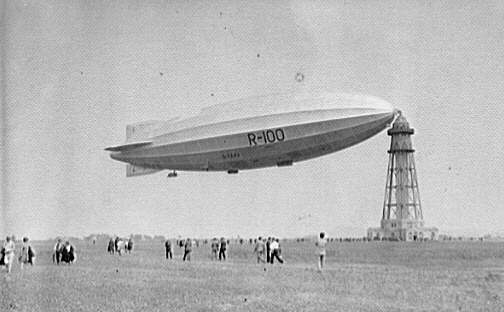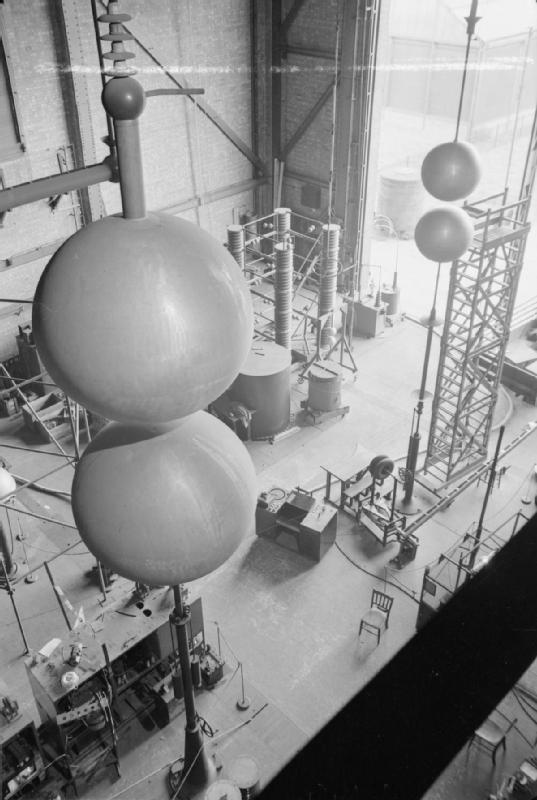|
Vickers Wild Goose
Wild Goose was a research unmanned aerial vehicle (UAV) developed and flown by designer Barnes Wallis for his research into tailless variable-sweep aircraft incorporating a radical new control system and capable of high-speed, long-range performance. Development After World War II, designer Barnes Wallis turned his attention from bombs back to aircraft. He undertook a fundamental review of the technology required for high-speed, long-distance flight and concluded that a tailless variable-sweep wing offered major advantages over conventional designs. A major part of this advantage was a radical revision of the flight control system. Control would primarily be effected by moving the wings in flight, avoiding the need for conventional control surfaces or tail. The change was so radical that he even proposed that it should no longer be thought of as an aeroplane but as a new type of flying machine, which he called a wing-controlled aerodyne. Wallis named the project Wild Goose. H ... [...More Info...] [...Related Items...] OR: [Wikipedia] [Google] [Baidu] |
Barnes Wallis
Sir Barnes Neville Wallis (26 September 1887 – 30 October 1979) was an English engineer and inventor. He is best known for inventing the bouncing bomb used by the Royal Air Force in Operation Chastise (the "Dambusters" raid) to attack the dams of the Ruhr Valley during World War II. The raid was the subject of the 1955 film '' The Dam Busters'', in which Wallis was played by Michael Redgrave. Among his other inventions were his version of the geodetic airframe and the earthquake bomb. Early life and education Barnes Wallis was born in Ripley, Derbyshire, to Charles William George Robinson Wallis (1859–1945) and his wife Edith Eyre Wallis née Ashby (1859–1911). He was educated at Christ's Hospital in Horsham and Haberdashers' Aske's Hatcham Boys' Grammar School in southeast London, leaving school at seventeen to start work in January 1905 at Thames Engineering Works at Blackheath, southeast London. He subsequently changed his apprenticeship to J. Samue ... [...More Info...] [...Related Items...] OR: [Wikipedia] [Google] [Baidu] |
Vickers Swallow
The Vickers Swallow was a supersonic aircraft project headed by Barnes Wallis, working at the British aircraft company Vickers-Armstrongs. It was a wing controlled aerodyne, controlled in flight by movement of the entire wing, and was the supersonic successor to the Wild Goose project. Several remotely piloted vehicles were built and flown for research purposes in addition to ground testing of static models. A conceptual full-scale aircraft was envisioned as a long distance airliner and, later on, as a potential supersonic successor to the Vickers Valiant, a subsonic V bomber then in service with the Royal Air Force. The project was cancelled in 1957 following the withdrawal of government backing. Development In the years following the Second World War, there was significant interest in developing a new generation of aircraft designs based upon knowledge acquired during the conflict. British engineer and inventor Barnes Wallis, a long term employee of the aircraft company ... [...More Info...] [...Related Items...] OR: [Wikipedia] [Google] [Baidu] |
Unmanned Aerial Vehicle
An unmanned aerial vehicle (UAV), commonly known as a drone, is an aircraft without any human pilot, crew, or passengers on board. UAVs are a component of an unmanned aircraft system (UAS), which includes adding a ground-based controller and a system of communications with the UAV. The flight of UAVs may operate under remote control by a human operator, as remotely-piloted aircraft (RPA), or with various degrees of autonomy, such as autopilot assistance, up to fully autonomous aircraft that have no provision for human intervention. UAVs were originally developed through the twentieth century for military missions too "dull, dirty or dangerous" for humans, and by the twenty-first, they had become essential assets to most militaries. As control technologies improved and costs fell, their use expanded to many non-military applications.Hu, J.; Bhowmick, P.; Jang, I.; Arvin, F.; Lanzon, A.,A Decentralized Cluster Formation Containment Framework for Multirobot Systems IEEE T ... [...More Info...] [...Related Items...] OR: [Wikipedia] [Google] [Baidu] |
Tailless Aircraft
In aeronautics, a tailless aircraft is an aircraft with no other horizontal aerodynamic surface besides its main wing. It may still have a fuselage, vertical tail fin (vertical stabilizer), and/or vertical rudder. Theoretical advantages of the tailless configuration include low parasitic drag as on the Horten H.IV soaring glider and good stealth characteristics as on the Northrop B-2 Spirit bomber. Disadvantages include a potential sensitivity to trim. Tailless aircraft have been flown since the pioneer days; the first stable aeroplane to fly was the tailless Dunne D.5, in 1910. The most successful tailless configuration has been the tailless delta, especially for combat aircraft, though the most familiar tailless delta is the Concorde airliner. NASA has used the 'tailless' description for the novel X-36 research aircraft which has a canard foreplane but no vertical fin. Aircraft configuration A tailless aircraft has no other horizontal surface besides its main wing. T ... [...More Info...] [...Related Items...] OR: [Wikipedia] [Google] [Baidu] |
Variable-sweep Wing
A variable-sweep wing, colloquially known as a "swing wing", is an airplane wing, or set of wings, that may be swept back and then returned to its original straight position during flight. It allows the aircraft's shape to be modified in flight, and is therefore an example of a variable-geometry aircraft. A straight wing is most efficient for low-speed flight, but for an aircraft designed for transonic or supersonic flight it is essential that the wing be swept. Most aircraft that travel at those speeds usually have wings (either swept wing or delta wing) with a fixed sweep angle. These are simple and efficient wing designs for high speed flight, but there are performance tradeoffs. One is that the stalling speed is increased, necessitating long runways (unless complex high-lift wing devices are built in). Another is that the aircraft's fuel consumption during subsonic cruise is higher than that of an unswept wing. These tradeoffs are particularly acute for naval carrier-base ... [...More Info...] [...Related Items...] OR: [Wikipedia] [Google] [Baidu] |
World War II
World War II or the Second World War, often abbreviated as WWII or WW2, was a world war that lasted from 1939 to 1945. It involved the World War II by country, vast majority of the world's countries—including all of the great powers—forming two opposing military alliances: the Allies of World War II, Allies and the Axis powers. World War II was a total war that directly involved more than 100 million Military personnel, personnel from more than 30 countries. The major participants in the war threw their entire economic, industrial, and scientific capabilities behind the war effort, blurring the distinction between civilian and military resources. Air warfare of World War II, Aircraft played a major role in the conflict, enabling the strategic bombing of population centres and deploying the Atomic bombings of Hiroshima and Nagasaki, only two nuclear weapons ever used in war. World War II was by far the List of wars by death toll, deadliest conflict in hu ... [...More Info...] [...Related Items...] OR: [Wikipedia] [Google] [Baidu] |
R100
His Majesty's Airship R100 was a privately designed and built British rigid airship made as part of a two-ship competition to develop a commercial airship service for use on British Empire routes as part of the Imperial Airship Scheme. The other airship, the R101, was built by the British Air Ministry, but both airships were funded by the Government. R100 was built by the Airship Guarantee Company, a specially created subsidiary of the armaments firm Vickers-Armstrongs, led by Commander Dennis Burney. The design team was headed by Barnes Wallis, later famous for his invention of the bouncing bomb. The design team also included Nevil Shute Norway as the senior stress engineer (see his '' Slide Rule: Autobiography of an Engineer''). R100 first flew in December 1929. It made a series of trial flights and a successful return crossing of the Atlantic in July–August 1930, but following the crash of R101 in October 1930 the Imperial Airship Scheme was terminated and R100 was b ... [...More Info...] [...Related Items...] OR: [Wikipedia] [Google] [Baidu] |
National Physical Laboratory (United Kingdom)
The National Physical Laboratory (NPL) is the national measurement standards laboratory of the United Kingdom. It is one of the most extensive government laboratories in the UK and has a prestigious reputation for its role in setting and maintaining physical standards for British industry. Founded in 1900, it is one of the oldest metrology institutes in the world. Research and development work at NPL has contributed to the advancement of many disciplines of science, including the development early computers in the late 1940s and 1950s, construction of the first accurate atomic clock in 1955, and the invention and pioneering implementation of packet switching in the 1960s, which is today one of the fundamental technologies of the Internet. The former heads of NPL include many individuals who were pillars of the British scientific establishment. NPL is based at Bushy Park in Teddington, west London. It is under the management of the Department for Business, Energy and Industria ... [...More Info...] [...Related Items...] OR: [Wikipedia] [Google] [Baidu] |
Vickers Valiant
The Vickers Valiant was a British high-altitude jet bomber designed to carry nuclear weapons, and in the 1950s and 1960s was part of the Royal Air Force's " V bomber" strategic deterrent force. It was developed by Vickers-Armstrongs in response to Specification B.35/46 issued by the Air Ministry for a nuclear-armed jet-powered bomber. The Valiant was the first of the V bombers to become operational, and was followed by the Handley Page Victor and the Avro Vulcan. The Valiant was the only V bomber to have dropped live nuclear weapons (for test purposes).Blackman and Wright 2015, p. 33. In 1956, Valiants operating from Malta flew conventional bombing missions over Egypt for Operation Musketeer during the Suez Crisis. From 1956 until early 1966 the main Valiant force was used in the nuclear deterrence role in the confrontation between NATO and the Warsaw Pact powers. Other squadrons undertook aerial refuelling, aerial reconnaissance and Electronic Warfare. In 1962, in respo ... [...More Info...] [...Related Items...] OR: [Wikipedia] [Google] [Baidu] |
Vickers Aircraft
Vickers was a British engineering company that existed from 1828 until 1999. It was formed in Sheffield as a steel foundry by Edward Vickers and his father-in-law, and soon became famous for casting church bells. The company went public in 1867, acquired more businesses, and began branching out into military hardware and shipbuilding. In 1911, the company expanded into aircraft manufacture and opened a flying school. They expanded even further into electrical and railway manufacturing, and in 1928 acquired an interest in the Supermarine. Beginning in the 1960s, various parts of the company were nationalised, and in 1999 the rest of the company was acquired by Rolls-Royce plc, who sold the defence arm to Alvis plc. The Vickers name lived on in Alvis Vickers, until the latter was acquired by BAE Systems in 2004 to form BAE Systems Land Systems. History Early history Vickers was formed in Sheffield as a steel foundry by Edward Vickers and his father-in-law George Naylor in 1 ... [...More Info...] [...Related Items...] OR: [Wikipedia] [Google] [Baidu] |

.jpg)







